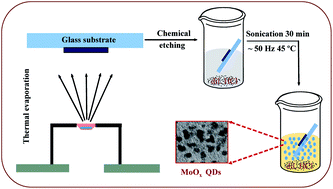Modified top-down approach for synthesis of molybdenum oxide quantum dots: sonication induced chemical etching of thin films
Abstract
A simple and modified top-down approach to synthesize molybdenum oxide (MoOx: x = 2, 3) quantum dots (QDs) is proposed in this study. This modified approach involves the conversion of a bulk powder material into thin films followed by a sonication induced chemical etching process for synthesising QDs. X-Ray Diffraction (XRD) is used for crystal structural characterization of MoOx thin films. The crystal structure properties of the MoOx QDs are analysed by High Resolution Transmission Electron Microscopy (HRTEM) images and corresponding Selected Area Electron Diffraction (SAED) patterns. The optical band gap is estimated by Tauc's plot from UV-Vis-NIR absorption spectra. The excitation dependent photoluminescence (PL) emission of MoOx QDs as a function of acid concentration is investigated. The growth mechanism of QDs in different crystalline phases as a function of acid concentration is also exemplified in this work. The micro-Raman and Fourier Transform of Infrared (FTIR) spectra are recorded to analyse the vibrational spectrum of the molybdenum–oxygen (Mo–O) bonds in the MoOx QDs.



 Please wait while we load your content...
Please wait while we load your content...